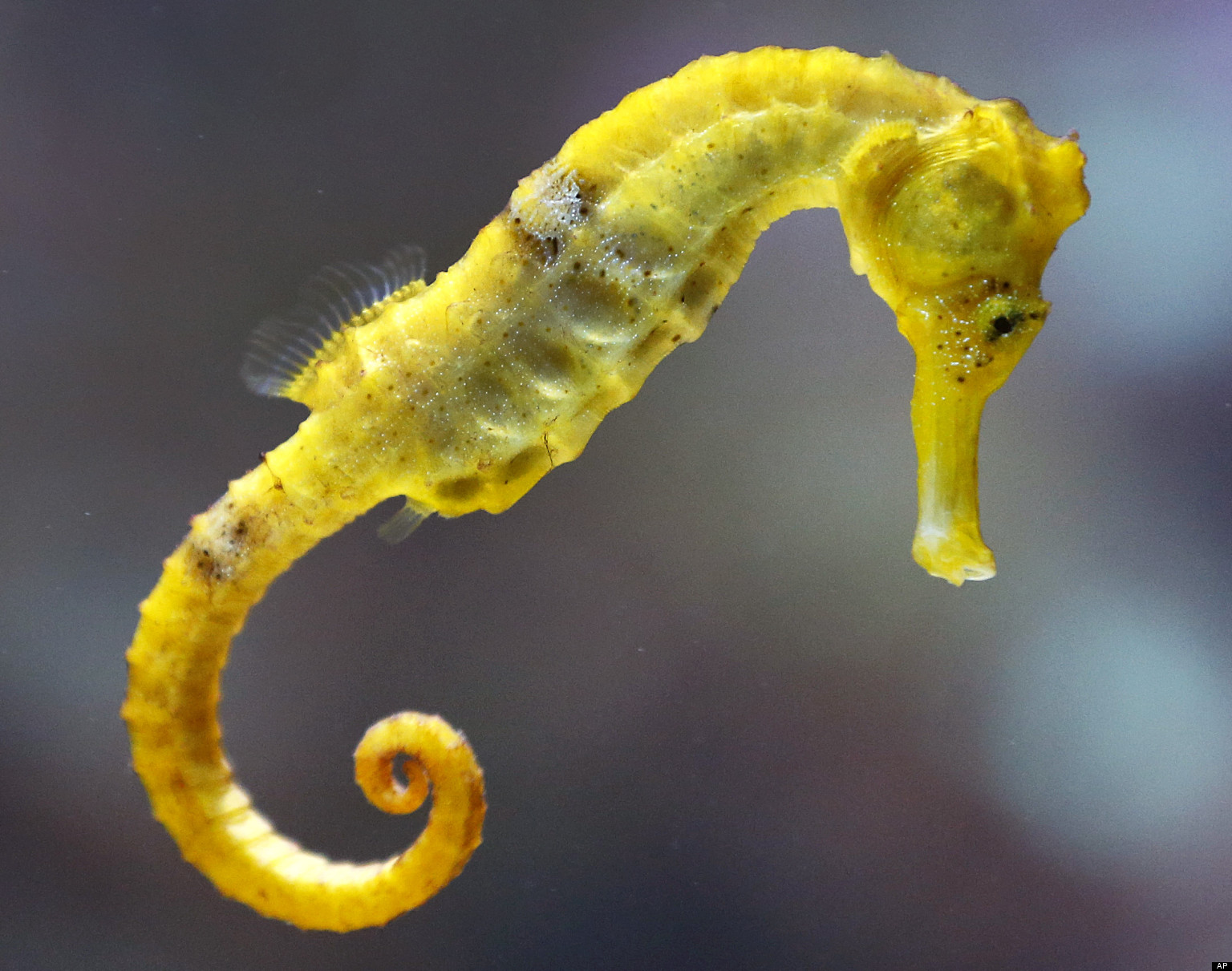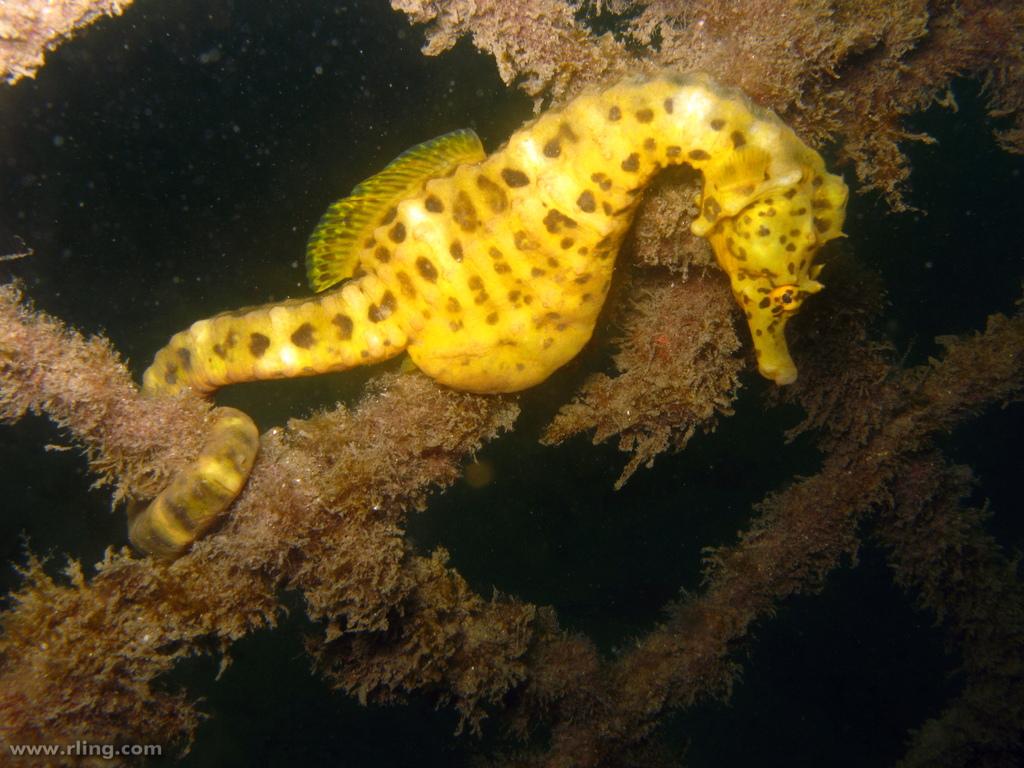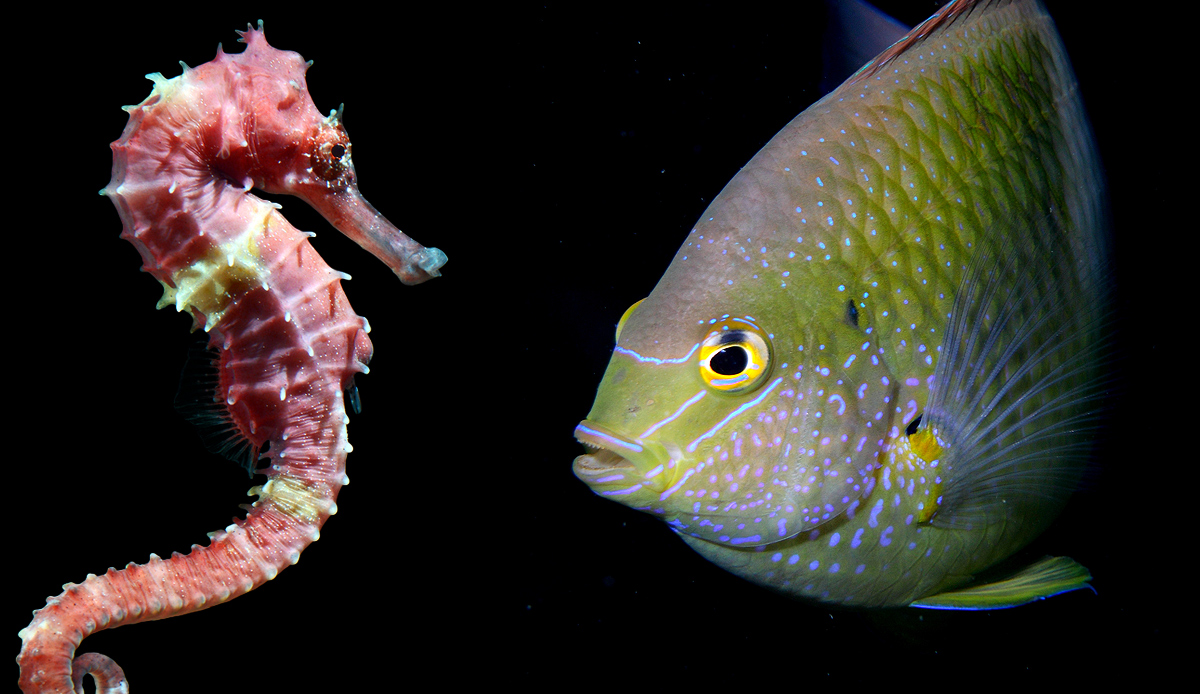
Seahorses are highly unusual fish. First, they swim upright and poorly. They lack the tail fin that provides other fish with most of their swimming power; instead seahorses use a small dorsal fin to move forward, pectoral fins near the head to turn and steer, and a swim bladder to move up or down in the water. Second, their shape is unique: They have a pronounced horse-shaped head at a right angle to their rough body, and a prehensile tail. Their snout is adapted for aspirating passing crustaceans, filtering the water through their gills. Their eyes move independently, permitting them to observe prey and their environment without moving. Their body is prickly and knobby, due to bony rings perpendicular to their backbones. Their tail permits them to anchor themselves by grasping vegetation or coral. Third, as they use camouflage to escape predators, they can grow tendrils from their skin to look like sea plants and, like chameleons, can change color to match their surroundings. They can also change color in response to other seahorses, brightening in response to a mate and darkening in submission to a rival. The thirty-five seahorse species differ in size, shape, color, and habitat. The smallest, Hippocampus bargibanti (called the pygmy seahorse), is a mere 1.3 centimeters (0.5 inches) from snout to tail, while the largest, H. ingens (the Pacific seahorse), is 35 centimeters (14 inches) long. Although seahorses generally look alike, the species differ in the number of bony rings around their bodies and tails, and one, H. abdominalis (the big belly seahorse), has a very pronounced abdomen. They vary in color, including pink, orange, yellow, brown, gray, and black, with the male usually the more colorful. They live in salt water at a depth of one to twenty-five meters (three to eighty feet), at a temperature of 6 to 30 degrees Celsius (43 to 86 degrees Fahrenheit), and in one of three coastal habitats: sea grass, mangroves, and coral reefs. The species are specific to different locations; for instance, H. bargibanti is found around the island ofNewCaledonia in the west Pacific, H. ingens inhabits the subtropical west coasts of North, Central and South America, while H. abdominalis exists around New Zealand, as well as on the southern and eastern coasts of Australia.
The Life Cycle of Seahorses
Depending on the species and location, seahorses may have a breeding season (generally during the warmer time of the year) or may reproduce continuously. Most seahorses appear to form monogamous relationships, although H. abdominalis is promiscuous. When the male is receptive, the pair will perform a mating dance that may last for hours to a day, ending with the female depositing her eggs through her ovipositor into the brooding pouch of the male, who will fertilize them with his semen. That the male becomes pregnant is the most unusual feature of seahorses. He provides the fertilized eggs with oxygen and food through a capillary network in the pouch, which also removes waste products. The incubation period depends on the species and conditions, lasting from ten days to six weeks. When the fully formed young hatch, they are expelled froman opening in the pouch in a rhythmic process that may last up to two days. The number of offspring born typically varies from 10 for the smallest species to 200, although the record is 1,572. The male will usually become immediately pregnant again. The young must find food, such as larval crustaceans, and must avoid predation from fish, water birds, or crabs. In addition, storms may sweep them out to sea attached to seaweed, and disperse them to environments to which they may not be suited. If they find sufficient food and avoid predation, they can mature in four to six months, mate, and procreate. While most seahorses do not survive to maturity, they can live from one to four years, depending on the species.
Future of Seahorses
Overfishing is a serious threat to the future of seahorses. The demand for them is large in traditional Asian medicine, where they are touted as cures for everything from asthma and heart disease to incontinence and impotence.Anestimated twenty million seahorses are so used annually. Live animals are also sold for aquariums, where maintaining them is difficult because of their nutritional preference for live crustaceans and their susceptibility to disease. In addition, drag net fishing in coastal areas harvests seahorses inadvertently. Any destruction of sea grass beds, mangroves, or coral reefs also poses a threat to these fascinating animals. Their future depends on sustainable fishing in the wild and developing seahorse aquaculture, as well as minimizing unintentional harvest and habitat destruction.
Seahorse Facts
Classification:
Kingdom: Animalia
Subkingdom: Bilateria
Phylum: Chordata
Subphylum: Vertebrata
Class: Pisces
Subclass: Teleostei
Superorder: Acanthopterygii
Order: Gasterosteiformes
Suborder: Syngnothoidei
Family: Syngnathidae
Genus and species: Hippocampus hippocampus, H. guttulatus and H.
kuda (spotted seahorse), H. zosterae (dwarf seahorse)
Geographical location: Subtropical coastal regions around the
world
Habitat: Shallow coastal areas that contain sea grass, mangroves,
or coral reefs
Incubation period: Ten days to six weeks, depending on the species
and habitat
Life span: One to four years, depending on the species and environment
Special anatomy: The male has a brood pouch on its abdomen in
which the female deposits its eggs; the male fertilizes them inside
the pouch and incubates them, expelling the newly
hatched, fully developed, but minuscule offspring through an
opening in the pouch; seahorses have a prehensile tail that permits
them to attach themselves to vegetation or coral
Other popular Animals
Photo Gallery of - Seahorse








 Animalia Life
Animalia Life